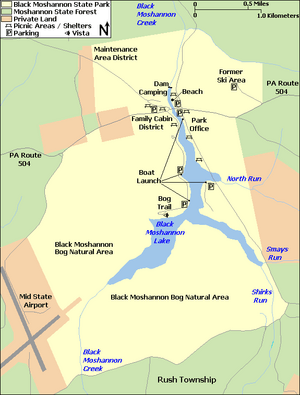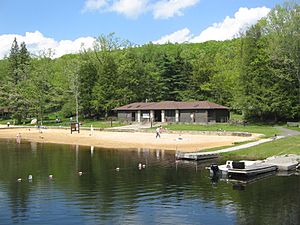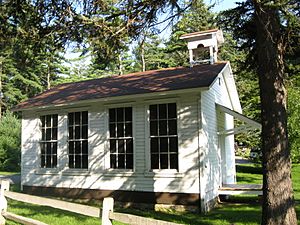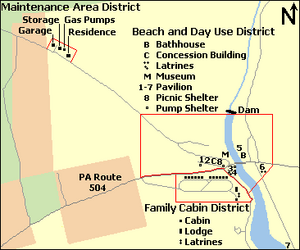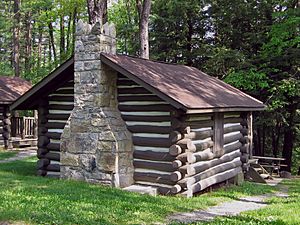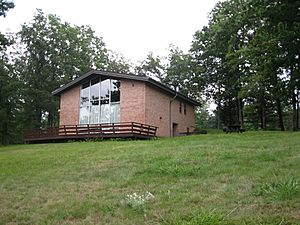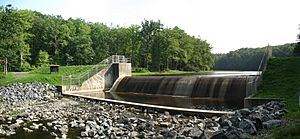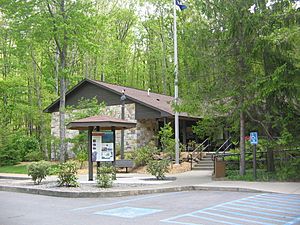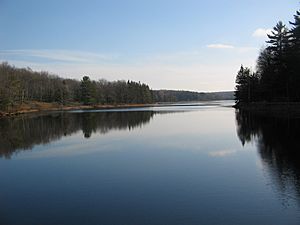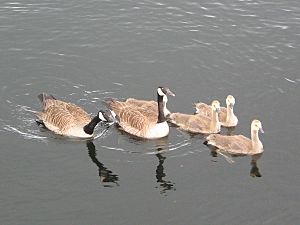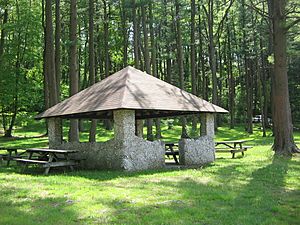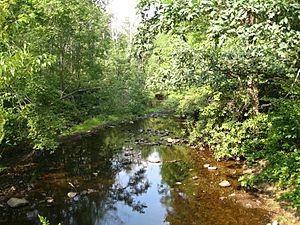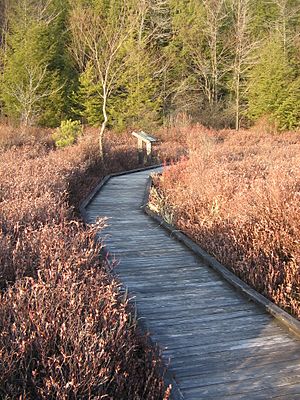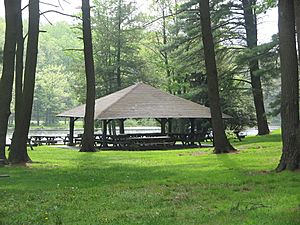Black Moshannon State Park facts for kids
Quick facts for kids Black Moshannon State Park |
|
|---|---|
|
IUCN Category III (Natural Monument)
|
|

View of bog and lake from the bog trail in the Black Moshannon Bog Natural Area at Black Moshannon State Park
|
|
| Location | Rush, Centre, Pennsylvania, United States |
| Area | 3,480 acres (14.1 km2) |
| Elevation | 1,919 ft (585 m) |
| Established | 1937 |
| Named for | Black Moshannon Creek |
| Visitors | 316,000 (in 2019) |
| Governing body | Pennsylvania Department of Conservation and Natural Resources |
| Website | Black Moshannon State Park |
Black Moshannon State Park is a large park in Rush Township, Centre County, Pennsylvania. It covers about 3,480 acres (1,410 ha) (that's over 5 square miles!). The park is famous for Black Moshannon Lake. This lake was made by a dam on Black Moshannon Creek. The creek and lake give the park its name.
The park is located west of the Allegheny Front. It's about 9 miles (14 km) east of Philipsburg. Much of the park is surrounded by Moshannon State Forest. A special wet area called a bog is found in the park. This bog is home to many unique plants and animals. You can find carnivorous plants and orchids here. These plants are usually found much farther north. The park has the "largest restored bog in Pennsylvania". Because of this, it's on the "25 Must-see Pennsylvania State Parks" list.
People have used the Black Moshannon area for a very long time. The Seneca tribe used to hunt and fish here. Later, European settlers cleared land for farms. They also cut down huge old-growth trees. These were mostly white pine and eastern hemlock. After the trees were cut, wildfires damaged the land.
The park we see today grew from these damaged forests. The Civilian Conservation Corps (CCC) helped bring the forests back. This happened during the Great Depression in the 1930s. Many buildings built by the CCC are still in the park. They are now protected as National Register of Historic Places sites.
Black Moshannon State Park is open all year for fun activities. It has many trails for hiking and biking. You can also explore the bog habitat. The park is an Important Bird Area. Bird watchers have seen 175 different bird species here. Many rare plants and animals live here too. This is because the park is high up on the Allegheny Plateau. The lake is about 1,900 feet (580 m) high.
You can go hunting in most of the park. The lake and creek are great for fishing, boating, and swimming. In winter, it's a popular spot for cross-country skiing. There was even a small downhill skiing area here from 1965 to 1982. Picnics and camping are also popular. A group called "Friends of Black Moshannon State Park" helps support the park.
Contents
History of Black Moshannon State Park
Native Americans and the Land
People have lived in Pennsylvania for a very long time. The first people were Paleo-Indian hunters. They were nomads who moved around. Later, people in the Archaic period used better stone tools. The Woodland period saw people start to live in villages. They also began to grow plants for food.
The Black Moshannon Creek area was home to the Susquehannock tribe. They lived in large long houses. They were a matriarchial society. Sadly, diseases from European settlers and wars caused their numbers to drop. By 1675, they had mostly disappeared.
After this, the Iroquois tribe controlled the land. The Iroquois lived mostly in New York. They were a strong confederacy. They let other tribes, like the Lenape, settle here.
The Seneca, part of the Iroquois, lived near Black Moshannon Lake. At that time, the lake was a series of beaver ponds. These tribes hunted, fished, and traded. A major native path, the Great Shamokin Path, crossed Black Moshannon Creek. But no paths went right through the park itself. Today, the park has a 1-mile (1.6 km) "Indian Trail". It reminds us of these early paths.
The French and Indian War (1754–1763) caused many Native Americans to move west. In 1768, the British bought this land from the Iroquois. After the American Revolutionary War, most Native Americans left Pennsylvania.
The name Moshannon comes from a Lenape word. Mos'hanna'unk means "elk river place". "Black Moshannon" refers to the dark water. This dark color comes from plant tannins in the bog.
The Lumber Era
Before settlers arrived, Pennsylvania was mostly covered in old-growth forest. These forests had huge white pine and eastern hemlock trees. Early settlers used timber to build homes and clear land. As time went on, the demand for lumber grew. By the time of the American Revolution, logging reached the mountains.
Lumber became a huge industry in Pennsylvania. Trees were used for fuel, leather tannin, and building. Large areas were cut to make charcoal for iron furnaces. The Philadelphia–Erie Pike (now Pennsylvania Route 504) opened the Black Moshannon area in 1821. Early settlers opened a Tavern and farmed.
By the mid-1800s, logging came to this area. Lumbermen cut trees and sent logs down the creeks. The logs went to sawmills in Williamsport. Lumber was also moved by sled and wagon to nearby towns.
The Beaver Mill Lumber Company became one of the biggest logging companies. Four logging towns grew in the area: Beaver Mills, Star Mill, Underwood Mills, and Antes. A dam was built where an old beaver dam was. The mill ponds flooded the old beaver ponds. These towns had stores, blacksmiths, and schools. They helped provide timber for mining and railroads.
Some trails in the park today remind us of this time. The 1.1-mile (1.8 km) Hay Road Trail was used by farmers. The 0.8-mile (1.3 km) Seneca Trail goes through a second growth forest. You can see stumps from the old trees. The Shingle Mill Trail is 3.67-mile (5.91 km) long. It follows Black Moshannon Creek. You can still see remains of Star Mill, a sawmill from 1879, on the 2.1-mile (3.4 km) Star Mill Trail.
This logging boom didn't last. Soon, the trees were gone. The land was left bare and damaged by erosion and wildfires. In the late 1800s and early 1900s, Pennsylvania bought this land. They started to replant the forests. By the 1930s, the area was already used for picnics and camping. People swam and fished in the old mill pond. The 0.2-mile (320 m) Tent Hill Trail still goes from the campsites to the lake beach.
The Civilian Conservation Corps (CCC)
The Civilian Conservation Corps (CCC) was a program started in 1933. It helped young men from families who didn't have jobs. President Franklin D. Roosevelt created it during the Great Depression. The CCC worked in every U.S. state. They built the first facilities at Black Moshannon State Park from 1933 to 1937.
Beaver Meadow CCC Camp S-71 opened in May 1933. Over 200 young men moved in. They worked to protect soil, water, and trees. They built roads to fight wildfires. They also planted many red pine trees to regrow the forest.
Most of the buildings the CCC built are still used today. These include log cabins, picnic shelters, and trails. The CCC also built a dam at Black Moshannon Lake. This was on the site of the old mill pond dam. CCC Camp S-71 closed in 1937. Black Moshannon State Park officially opened that same year.
Historic Buildings
In 1987, three areas with CCC buildings were added to the National Register of Historic Places. These buildings were made between 1933 and 1937. They are part of the Beach and Day Use, Family Cabin, or Maintenance Historic Districts.
The Beach and Day Use Historic District has 18 protected buildings. These include picnic pavilions, a picnic shelter, and water pump shelters. The concession building, beach bathhouse, and museum are also protected.
The Family Cabin Historic District has 16 protected buildings. These are 13 log cabins, one lodge, and two outdoor toilets. The cabins are lined up like old-fashioned motor courts. The Lodge is a large building with a stone fireplace.
The Maintenance Historic District includes four CCC buildings. These are a storage building, a garage, a gas pump house, and the Park Ranger's home.
Modern Changes
Since 1937, Black Moshannon State Park has changed a lot. In 1941, the park was planned to grow to 1,000 acres (400 ha). The "Black Moshannon Airport" was built on park land before World War II. It opened in 1942 and was renamed "Mid-State Airport" in 1962. Today, it's called "Mid-State Regional Airport" and covers 500 acres (200 ha).
The park had a ski resort from the 1960s to 1982. It opened in 1965. Skiers used tow ropes to get up the slopes. The ski lodge is now Cabin 20 and can be rented. The Ski Slope Trail is a 2-mile (3.2 km) hiking trail. It goes near the old ski slope.
In 1954, the park was officially named "Black Moshannon State Park". The CCC-built dam was replaced in the 1950s. The current Kephart Dam was built in 1974. Many changes happened between 1971 and 1980. Some old buildings were changed or removed. The museum became the Environmental Learning Center. New modern cabins were built. Today, the park also has a park office, boat launches, and modern restrooms.
The park started getting special recognition in the 1980s. The three Historic Districts were added to the National Register in 1987. In 1994, the "Black Moshannon Bog Natural Area" was created. This protects the park's unique bog. In 1997, the park became an Important Bird Area (IBA). By 2001, over 350,000 people visited the park each year. The Pennsylvania Department of Conservation and Natural Resources (DCNR) calls Black Moshannon one of its "25 Must-see Pennsylvania State Parks". They say it has the "largest restored bog in Pennsylvania".
Nature and Environment
Geology and Climate
The ground under Black Moshannon State Park is mostly shale, sandstone, and coal. These rocks formed from ancient seas about 300 to 350 million years ago. The park has three main rock types from the Carboniferous period.
The park is 1,919 feet (585 m) high on the Allegheny Plateau. This plateau is next to the Allegheny Front. The Allegheny Front is a steep rise of 1,300 feet (400 m). The Allegheny Plateau and Appalachian mountains formed about 300 million years ago.
The lake in the park is about 1,900 feet (580 m) high. The park sits in a natural bowl. The bowl and the sandstone underneath trap water. This creates the lake and the bogs. Being high up means the park has a cooler climate. The bowl shape also traps cool air. This leads to longer winters and milder summers.
The cooler climate means the park is home to plants and animals usually found farther north. The Allegheny Plateau has a continental climate. Winters can be very cold. Summers are mild. The average rainfall is about 40 to 42 inches (1016 to 1067 mm) per year. The soil here is mostly from sandstone. This means it can't easily stop acid rain from harming the environment. The hottest temperature recorded was 97 °F (36 °C) in 1988. The coldest was −25 °F (−32 °C) in 1994.
| Climate data for Black Moshannon State Park | |||||||||||||
|---|---|---|---|---|---|---|---|---|---|---|---|---|---|
| Month | Jan | Feb | Mar | Apr | May | Jun | Jul | Aug | Sep | Oct | Nov | Dec | Year |
| Mean daily maximum °F (°C) | 31 (−1) |
35 (2) |
44 (7) |
57 (14) |
67 (19) |
74 (23) |
78 (26) |
76 (24) |
69 (21) |
58 (14) |
46 (8) |
35 (2) |
56 (13) |
| Mean daily minimum °F (°C) | 16 (−9) |
18 (−8) |
26 (−3) |
35 (2) |
45 (7) |
53 (12) |
57 (14) |
56 (13) |
49 (9) |
39 (4) |
32 (0) |
21 (−6) |
37 (3) |
| Average precipitation inches (mm) | 2.72 (69) |
2.49 (63) |
3.33 (85) |
3.25 (83) |
4.03 (102) |
4.81 (122) |
4.19 (106) |
3.56 (90) |
4.17 (106) |
3.08 (78) |
3.47 (88) |
2.73 (69) |
41.83 (1,061) |
| Source: The Weather Channel | |||||||||||||
Bog Natural Area
The bogs in the park have a lot of sphagnum moss. This moss breaks down very slowly. It builds up layers of dead moss, creating peat. In 1994, 1,592 acres (644 ha) of bog were protected. This area is called the "Black Moshannon Bog Natural Area". By 2008, the protected bog area grew to 1,992 acres (806 ha).
Most bogs are found in areas that were once covered by glaciers. But Black Moshannon State Park was not glaciated. The bogs here formed because of flat sandstone beds underground. The sandstone doesn't absorb water well. So, water collects in any low spots. The bogs stretch along the lake's shores. Many migratory shorebirds visit here. These include greater and lesser yellowlegs, least sandpiper, and solitary sandpiper.
The water in the bog has few nutrients and is very acidic. This makes it hard for most plants to grow. Only special plants can live here. There are three types of carnivorous plants and seventeen kinds of orchid. Wild cranberries and blueberries also grow in the bog. The bogs are protected by Pennsylvania.
Wildlife in the Park
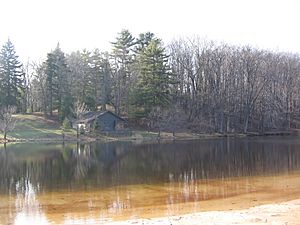
You can often see White-tailed deer, wild turkey, ruffed grouse, opossum, raccoon, hawks, chipmunks, porcupine, woodpeckers, and flying, red, and eastern gray squirrels. Black bears also live in the park. Many of these animals almost disappeared in the past. This was due to logging, pollution, and too much hunting. But hunting rules and efforts to regrow the forests have helped them come back.
The lake is home to American beavers. You can also see great blue heron, swans, snow geese, and common loons. Many other waterfowl visit, like Canada goose, ring-necked duck, and mallard. The bogs and marshes have frogs and salamanders. They also provide a home for carnivorous plants like the pitcher plant and sundew. Many common songbirds, like ovenbirds, live here too.
The conifer and mixed forests are home to birds like the northern saw-whet owl, blue-headed vireo, and hermit thrush. Deciduous forests have birds like scarlet tanager and red-eyed vireo.
In the mid-1980s, a non-native gypsy moth caused damage to some trees. The affected trees were cut down. Today, the 1.2-mile (1.9 km) Sleepy Hollow Trail goes through the new growth. This area is great for deer and wild turkey.
Important Bird Area
Pennsylvania's "Black Moshannon State Park & State Forest" is an Important Bird Area (IBA). It covers 45,667 acres (18,481 ha). This area includes parts of the state park, Moshannon State Forest, and the airport. The Audubon Society has named 3,374 acres (1,365 ha) of Black Moshannon State Park as an IBA. This means it's a very important habitat for bird conservation.
Bird watchers have seen 175 different bird species here. This is because the area has a large forest and many different habitats. The park's location on the Allegheny Front also helps attract many birds.
Black Moshannon Lake and the bogs are very important for the IBA. They are a resting spot for migratory waterfowl and shorebirds. You can see birds like pied-billed and Slavonian grebes, common loon, and American black duck.
The Allegheny Front is a main path for many birds of prey. Golden eagles, bald eagles, osprey, and northern harriers fly through here. Raptors that nest here include the northern goshawk, red-shouldered, and broad-winged hawks.
The cool, damp bogs are home to birds at the southern edge of their habitat. The Canada warbler and northern waterthrush nest in the bogs. Other birds like the alder flycatcher and common yellowthroat also live here.
Fun Activities at the Park
Cabins, Camping, Swimming, and Picnics
Visitors can stay in 21 cabins at Black Moshannon State Park. Thirteen are rustic cabins built by the CCC. They have lights, a stove, a fridge, and bunk beds. Six are modern cabins, including the old ski lodge. These have electric heat, bedrooms, living rooms, kitchens, and baths. There are also two deluxe camping cottages. You need to bring your own linens and cooking gear. Pets are not allowed in the cabins.
The park has 72 campsites. Each site has a fire ring and picnic table. There are washhouses with toilets, showers, and laundry. Some sites allow pets. There are also 12 sites with full hook-ups for RVs. A group tenting area can hold up to 60 people.
The sandy beach on Black Moshannon Lake is open from Memorial Day to Labor Day. The beach bathhouse was built by the CCC. Since 2008, lifeguards are not on duty.
There are eight picnic pavilions built by the CCC. You can reserve them for a fee. The park also has 250 picnic tables in four large areas. These are free to use if not reserved.
Some modern activities are not allowed. You cannot fly drones or use other remote-controlled devices. All-terrain vehicles (ATVs) are also not allowed. You cannot remove natural items or cut firewood without a permit.
Boating, Fishing, and Hunting
Boating is popular on Black Moshannon Lake, which is 250 acres (100 ha) big. Canoes, sailboats, and electric motor boats are allowed. They must be registered with the state. Black Moshannon Creek is great for whitewater canoeing and kayaking. The first 13.2-mile (21.2 km) of Class 2+ whitewater starts in the park.
You can fish in Black Moshannon Creek and its smaller streams. You'll find rainbow and brown trout that have been stocked for fishing. Black Moshannon Lake has warmer water. It has different fish like largemouth bass, yellow perch, chain pickerel, bullhead catfish, and northern pike.
Hunting is allowed in most of Black Moshannon State Park. This helps control animal populations. Common animals to hunt are ruffed grouse, eastern gray squirrel, wild turkey, and white-tailed deer. However, hunting groundhogs is not allowed.
Trails for Exploring
There are 21 miles (34 km) of trails at Black Moshannon State Park. All are open for hiking. Most are open for cross-country skiing in winter. Some trails are open for snowmobiles and mountain bikes. The park is very popular for cross-country skiing because it's so high up. The trails are mostly smooth for skiing.
- Allegheny Front Trail is a 41.8-mile (67.3 km) hiking trail. It goes through Black Moshannon State Park and Moshannon State Forest. It has great views from the Allegheny Front.
- Blueberry Trail is a 1-mile (1,600 m) loop. It goes between the airport and the bog. It has "abundant berries".
- Bog Trail is a 0.5-mile (800 m) boardwalk hiking trail. It was built to be easy for everyone to use. It goes through the bog. You can see lilies, sedges, and carnivorous plants. You might see waterfowl and wildlife.
- Lake Loop Trail is a 0.7-mile (1,100 m) loop. It crosses the Pennsylvania Route 504 bridge over the lake. It also crosses the bridge over Black Moshannon Creek.
- Moss-Hanne Trail is a 7.7-mile (12.4 km) trail. It goes through the Black Moshannon Bog Natural Area. It's open for hiking and cross-country skiing. The trail goes through pine forests, hardwood forests, and spruce groves. It also passes beaver ponds. The area can be wet, so waterproof shoes are a good idea. Bikes are not allowed on this trail.
- Snowmobile Trail is a 1.1-mile (1.8 km) trail. It starts behind Pavilion 6. It connects to many miles of snowmobile trails in Moshannon State Forest. In summer, it's open for hiking and mountain biking.
Friends of Black Moshannon State Park
The Friends of Black Moshannon State Park is a volunteer group. They help promote fun activities at the park. They also work with park staff to keep the park clean. They help with conservation projects.
The Summer Festival usually happens on the fourth weekend of July. Events at the festival remember the park's logging history. There are log rolling, axe throwing, and cross-cut sawing contests. You can also join canoe races and fishing contests on Black Moshannon Lake. A Saturday night bonfire party is held at the beach with music and snacks.
Nearby State Parks
The following state parks are within 30 miles (48 km) of Black Moshannon State Park:
|
See also
 In Spanish: Parque estatal Black Moshannon para niños
In Spanish: Parque estatal Black Moshannon para niños



